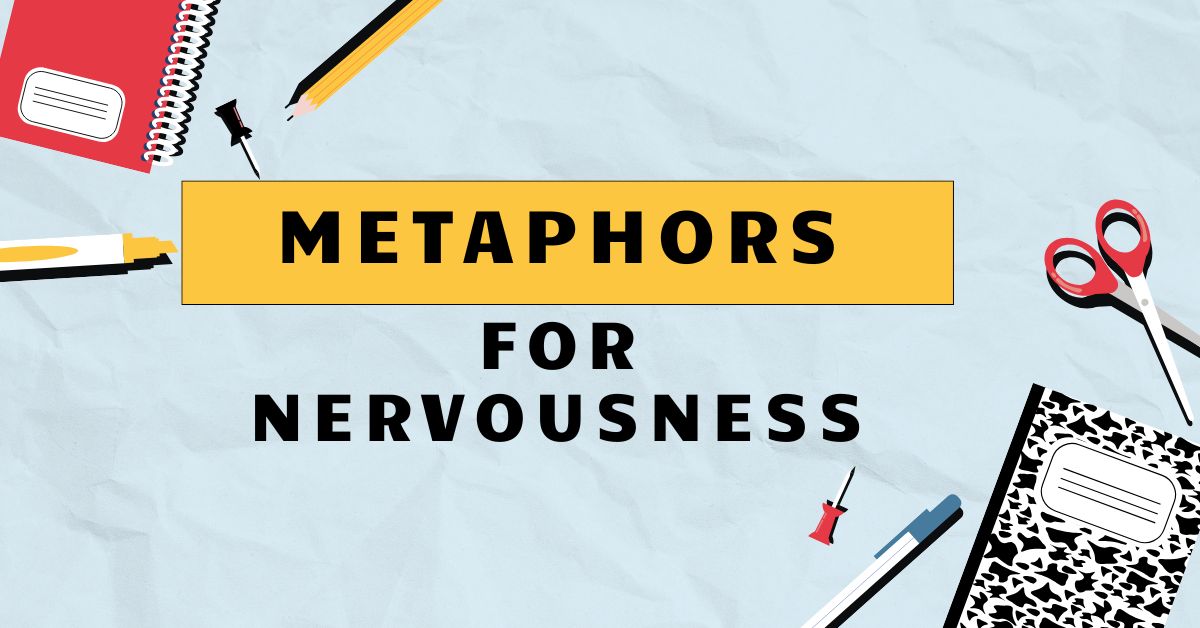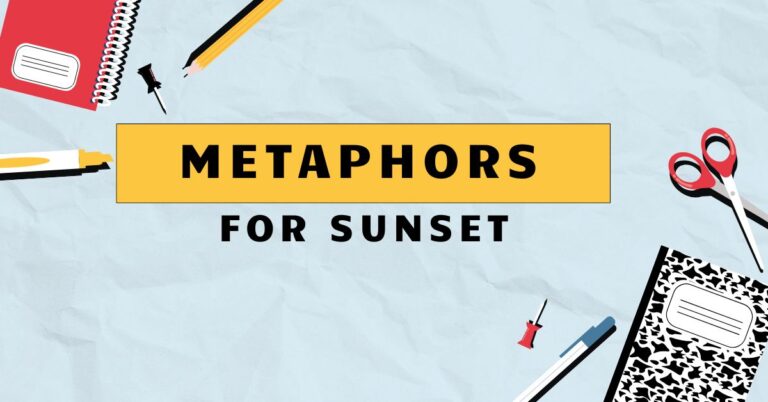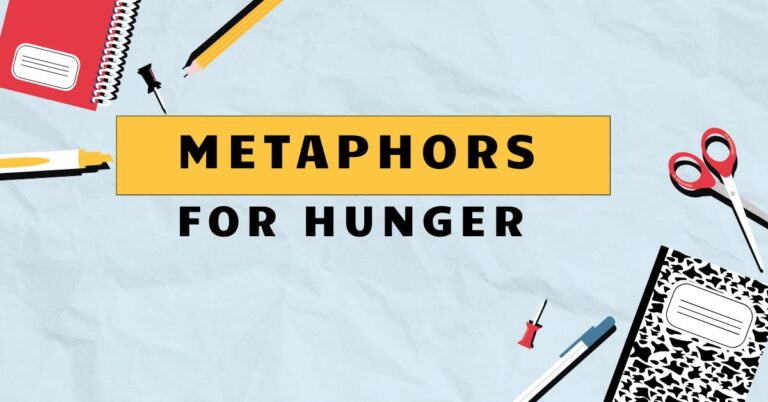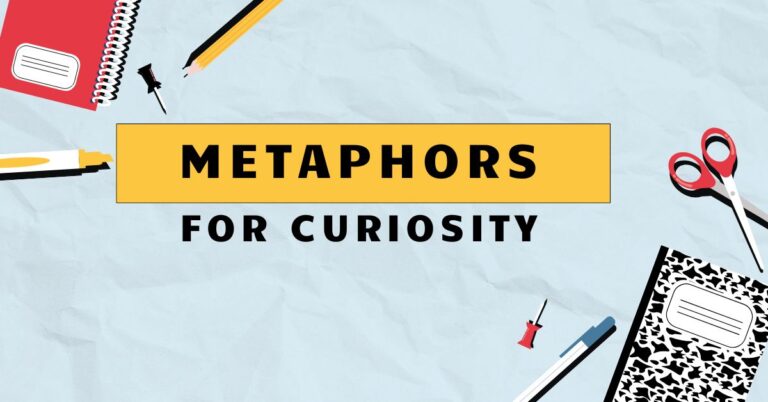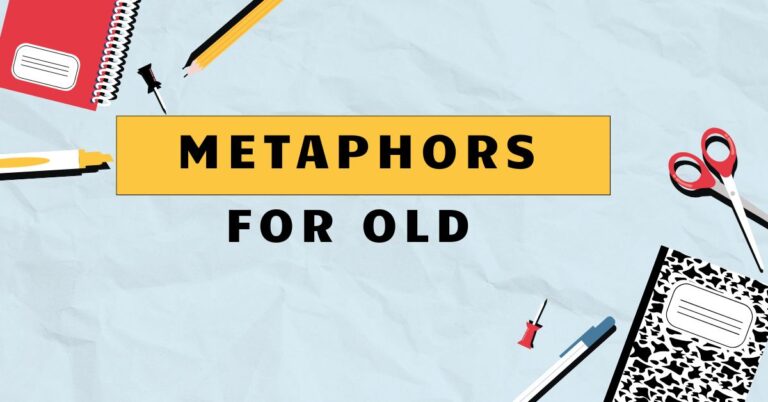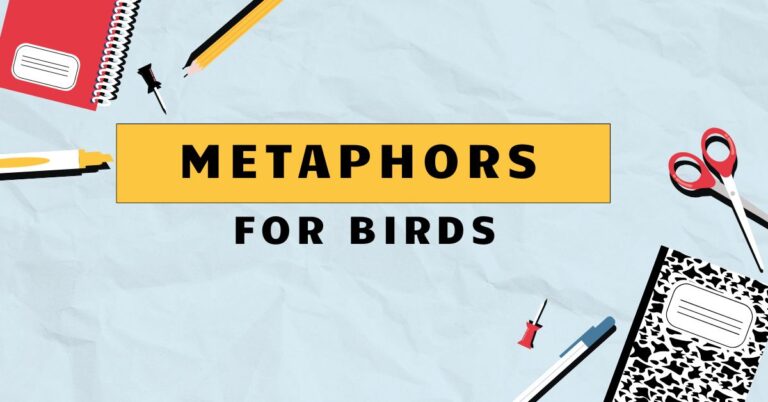39 Metaphors for Nervousness: Expressing Anxiety in English
Nervousness is a universal human experience, and English offers a rich tapestry of metaphors to describe it. Understanding these metaphors not only enhances your vocabulary but also provides deeper insights into how we conceptualize and communicate anxiety.
This article explores the various types of metaphors used to express nervousness, their structural elements, and common usage rules. This guide is beneficial for English language learners, writers looking to add nuance to their descriptions, and anyone interested in the expressive power of language.
Table of Contents
- Introduction
- Definition of Metaphor and Nervousness
- Structural Breakdown of Nervousness Metaphors
- Types and Categories of Nervousness Metaphors
- Examples of Nervousness Metaphors
- Usage Rules for Nervousness Metaphors
- Common Mistakes with Nervousness Metaphors
- Practice Exercises
- Advanced Topics in Nervousness Metaphors
- Frequently Asked Questions
- Conclusion
Definition of Metaphor and Nervousness
Ametaphoris a figure of speech that directly compares two unlike things without using “like” or “as.” It asserts that one thing *is* another, creating a vivid and often unexpected connection. Metaphors are powerful tools for conveying complex emotions and experiences in a relatable way.
They work by transferring qualities associated with one concept to another, enriching our understanding and adding depth to our language.
Nervousness, in the context of this article, refers to a state of unease, anxiety, or apprehension. It’s a feeling of being worried or agitated about something that is about to happen or may happen.
This emotional state often manifests physically, with symptoms like a racing heart, sweaty palms, or a trembling voice. Because nervousness is an internal experience, metaphors become particularly useful in expressing its intangible qualities.
Structural Breakdown of Nervousness Metaphors
Nervousness metaphors typically consist of two key elements: thetenorand thevehicle. The tenor is the subject being described (in this case, nervousness), and the vehicle is the object or concept to which the subject is being compared.
The effectiveness of a metaphor lies in the connection between the tenor and the vehicle – how the qualities of the vehicle illuminate or enhance our understanding of the tenor.
For example, in the metaphor “My stomach was a knot,” the tenor is the feeling of nervousness in the stomach, and the vehicle is a “knot.” The connection is the feeling of tightness, constriction, and discomfort associated with both a knot and a nervous stomach. The metaphor works because it effectively conveys the physical sensation of anxiety.
Another crucial aspect is theground, which refers to the shared characteristics between the tenor and the vehicle. The stronger the ground, the more effective and resonant the metaphor will be.
Identifying the ground helps to understand why a particular metaphor works and how it contributes to the overall meaning.
Types and Categories of Nervousness Metaphors
Nervousness metaphors can be categorized based on the type of vehicle used to describe the feeling. Common categories include physical sensations, animal behaviors, weather-related phenomena, mechanical malfunctions, and war/battle scenarios.
Each category offers a unique perspective on the experience of nervousness.
Physical Sensation Metaphors
These metaphors describe nervousness by comparing it to tangible physical sensations. They often involve feelings of heat, cold, pressure, or discomfort.
These metaphors tap into our direct experiences of the body, making them highly relatable and visceral. Examples include “butterflies in my stomach,” “cold feet,” and “a lump in my throat.”
Animal Behavior Metaphors
This category uses animal behaviors to represent nervousness. Animals often associated with anxiety include those that are skittish, restless, or prone to flight.
These metaphors evoke a sense of unease and a lack of control. Examples include “like a deer in headlights,” “jittery as a squirrel,” and “a caged tiger.”
Weather-Related Metaphors
Weather metaphors use storms, turbulence, and other atmospheric phenomena to describe the intensity of nervousness. These metaphors often convey a sense of impending doom or overwhelming pressure.
Examples include “a storm brewing inside,” “under a cloud of anxiety,” and “the calm before the storm.”
Mechanical Malfunction Metaphors
These metaphors compare nervousness to the breakdown or malfunction of a machine. They suggest a loss of control and a sense of being overwhelmed by internal processes.
Examples include “my mind racing,” “my gears grinding,” and “short-circuiting.”
War and Battle Metaphors
This category uses the imagery of war and battle to depict nervousness as an internal struggle. These metaphors often convey a sense of high stakes and intense pressure.
Examples include “battling my nerves,” “a war within,” and “facing my demons.”
Examples of Nervousness Metaphors
The following sections provide extensive examples of nervousness metaphors, organized by category. Each example is designed to illustrate the specific qualities and nuances of that particular type of metaphor.
Physical Sensation Examples
This table provides examples of metaphors that describe nervousness using physical sensations. These metaphors help to illustrate the tangible aspects of anxiety.
| Metaphor | Explanation |
|---|---|
| Butterflies in my stomach | A fluttering, uneasy feeling in the abdomen. |
| Cold feet | Hesitation or fear before an important event. |
| A lump in my throat | A feeling of tightness and difficulty speaking due to anxiety. |
| My heart was pounding | A rapid and forceful heartbeat due to stress. |
| Sweaty palms | Moist hands, a common physical manifestation of nervousness. |
| My skin was crawling | A sensation of unease and discomfort, as if something is moving on the skin. |
| A knot in my stomach | A tight, painful feeling in the abdomen. |
| Shivers down my spine | A sudden trembling sensation caused by fear or anticipation. |
| My hands were trembling | Uncontrolled shaking of the hands. |
| My voice cracked | A sudden change in pitch due to nervousness. |
| I felt a tightness in my chest | Constriction in the chest area, often associated with anxiety. |
| My head was spinning | A feeling of dizziness and disorientation. |
| I felt like I was going to faint | A sensation of lightheadedness and impending loss of consciousness. |
| My stomach churned | A feeling of nausea and unease. |
| I was on edge | Feeling tense and irritable. |
| My teeth were chattering | Involuntary shaking of the teeth due to cold or fear. |
| I was burning up with anxiety | Feeling intensely hot due to nervousness. |
| My muscles were tense | Tightness and stiffness in the muscles. |
| I felt a prickling sensation | A tingling or stinging feeling. |
| I was wired | Feeling jittery and overstimulated. |
| My throat was dry | Lack of saliva making swallowing difficult. |
| I felt a wave of nausea | Sudden feeling of wanting to vomit. |
| The room felt like it was closing in | Feeling trapped and claustrophobic. |
| My vision tunneled | Loss of peripheral vision due to panic. |
| I felt numb | Loss of sensation and emotional detachment. |
Animal Behavior Examples
This table showcases metaphors that use animal behavior to illustrate nervousness. These comparisons often highlight feelings of vulnerability and unease.
| Metaphor | Explanation |
|---|---|
| Like a deer in headlights | Frozen with fear and unable to react. |
| Jittery as a squirrel | Restless and easily startled. |
| A caged tiger | Restless and agitated due to confinement. |
| Like a fish out of water | Feeling uncomfortable and out of place. |
| A nervous cat | Easily frightened and jumpy. |
| Like a bird with a broken wing | Feeling helpless and unable to function properly. |
| A skittish horse | Easily spooked and difficult to control. |
| Like a trapped mouse | Feeling cornered and desperate. |
| A fluttering hummingbird | Energetic but anxious and unfocused. |
| Like a cornered rat | Feeling threatened and ready to defend oneself. |
| A trembling chihuahua | Small and visibly nervous. |
| Like a scared rabbit | Timid and prone to fleeing. |
| A hissing snake | Defensive and ready to strike. |
| Like a worm on a hook | Feeling vulnerable and exposed. |
| A pacing lion | Restless and anxious, full of pent-up energy. |
| Like a flock of startled birds | A sudden, collective feeling of panic. |
| A burrowing owl | Trying to hide from a stressful situation. |
| Like a spider spinning a frantic web | Feeling overwhelmed and trying to control the situation. |
| A chattering monkey | Restless and unable to focus. |
| Like a chameleon changing colors | Trying to adapt to a stressful environment. |
| A fluttering moth near a flame | Drawn to a stressful situation despite the danger. |
| Like a kangaroo about to bolt | Ready to flee at the first sign of trouble. |
| A shivering puppy | Small, vulnerable, and visibly afraid. |
| Like a bee trapped in a jar | Feeling confined and desperate to escape. |
| A trembling lamb | Innocent and easily frightened. |
Weather-Related Examples
This table presents metaphors that use weather phenomena to describe nervousness. These metaphors often convey the intensity and unpredictability of anxiety.
| Metaphor | Explanation |
|---|---|
| A storm brewing inside | A growing sense of unease and impending panic. |
| Under a cloud of anxiety | Feeling weighed down by worry. |
| The calm before the storm | A deceptive period of peace before a stressful event. |
| A whirlwind of emotions | Feeling overwhelmed by a mix of conflicting feelings. |
| A flood of anxiety | An overwhelming surge of worry. |
| Frozen with fear | Paralyzed by terror. |
| A blizzard of thoughts | An overwhelming rush of ideas and worries. |
| Swept away by panic | Overwhelmed and unable to control one’s reaction. |
| A heatwave of anxiety | An intense and overwhelming feeling of stress. |
| Lost in a fog of confusion | Disoriented and unable to think clearly. |
| A drizzle of worry | A persistent but mild feeling of anxiety. |
| Thunderstruck with fear | Suddenly and intensely frightened. |
| A hurricane of emotions | An extremely intense and destructive emotional experience. |
| Drowning in a sea of worry | Feeling overwhelmed and suffocated by anxiety. |
| A light shower of nerves | A mild and fleeting feeling of anxiety. |
| A torrential downpour of fear | An overwhelming and relentless feeling of terror. |
| A gentle breeze of unease | A subtle and barely perceptible feeling of anxiety. |
| A tsunami of panic | An overwhelming and destructive wave of fear. |
| A cold front of dread | An approaching feeling of impending doom. |
| A cyclone of worry | A spiraling and destructive pattern of anxious thoughts. |
| A sun shower of hope amidst the storm | A brief moment of optimism during a stressful time. |
| A fog lifting, revealing clarity | A moment of clear thinking after a period of confusion. |
| A rainbow after the storm | A feeling of relief and optimism after a stressful event. |
| A gathering storm on the horizon | An approaching sense of anxiety and unease. |
| A calm after the chaos | A period of peace and tranquility after a stressful ordeal. |
Mechanical Malfunction Examples
This table provides examples of metaphors that use mechanical malfunctions to describe nervousness. These metaphors often convey a sense of loss of control and internal chaos.
| Metaphor | Explanation |
|---|---|
| My mind racing | Thoughts moving rapidly and uncontrollably. |
| My gears grinding | Experiencing difficulty processing information. |
| Short-circuiting | Losing the ability to think clearly. |
| My engine sputtering | Experiencing difficulty performing tasks. |
| My battery draining | Feeling exhausted and depleted. |
| My system crashing | Experiencing a complete mental breakdown. |
| My circuits overloaded | Feeling overwhelmed by sensory input. |
| My hard drive failing | Experiencing memory loss or difficulty recalling information. |
| My wires crossed | Feeling confused and disoriented. |
| My motherboard frying | Experiencing severe mental fatigue. |
| My fan whirring out of control | Feeling overheated and agitated. |
| My processor overheating | Experiencing intense mental stress. |
| My software glitching | Experiencing minor mental errors or lapses in judgment. |
| My programming corrupted | Experiencing a fundamental shift in thought patterns. |
| My system rebooting | Attempting to regain control and composure. |
| My mainframe collapsing | Experiencing a catastrophic mental breakdown. |
| My gears stripped | Feeling unable to function properly. |
| My mechanisms seizing | Experiencing a complete mental shutdown. |
| My system going haywire | Experiencing a period of intense mental instability. |
| My internal clock malfunctioning | Feeling disoriented and losing track of time. |
| My gyroscope spinning wildly | Feeling unbalanced and out of control. |
| My internal compass failing | Feeling lost and unsure of what to do. |
| My pressure gauge maxing out | Feeling overwhelmed and on the verge of a breakdown. |
| My warning lights flashing | Receiving internal signals that something is wrong. |
| My emergency brakes failing | Feeling unable to stop a negative reaction. |
War and Battle Examples
This table presents metaphors that use the imagery of war and battle to describe nervousness. These metaphors often convey a sense of intense pressure and internal conflict.
| Metaphor | Explanation |
|---|---|
| Battling my nerves | Fighting against feelings of anxiety. |
| A war within | An internal struggle with conflicting emotions. |
| Facing my demons | Confronting personal fears and anxieties. |
| A siege of anxiety | Feeling surrounded and overwhelmed by worry. |
| Under attack by panic | Experiencing a sudden and intense wave of fear. |
| Fortifying myself against fear | Preparing mentally to face a stressful situation. |
| A battle of wills | Struggling to control one’s emotions. |
| Losing the fight against anxiety | Succumbing to feelings of worry and unease. |
| A skirmish with my nerves | A minor and fleeting episode of anxiety. |
| Waging war on my fears | Actively working to overcome personal anxieties. |
| A minefield of anxiety | Navigating a situation fraught with potential stressors. |
| A trench warfare of worry | A prolonged and exhausting struggle with anxiety. |
| Taking fire from my anxieties | Feeling bombarded by stressful thoughts and emotions. |
| A strategic retreat from fear | Avoiding situations that trigger anxiety. |
| A cavalry charge against my worries | Confronting anxieties head-on with determination. |
| A defensive posture against panic | Protecting oneself from overwhelming feelings of fear. |
| A guerilla warfare of anxiety | Dealing with unpredictable and intermittent episodes of worry. |
| A scorched earth policy against fear | Eliminating all potential sources of anxiety. |
| A bombing raid of panic | Experiencing a sudden and overwhelming attack of fear. |
| A peace treaty with my nerves | Achieving a state of emotional calm and stability. |
| A cold war with my anxieties | A constant, underlying tension with persistent worries. |
| A war of attrition against my fears | Gradually wearing down and overcoming anxieties over time. |
| A blitzkrieg of panic | A sudden and overwhelming attack of fear that quickly escalates. |
| A last stand against my anxieties | Making a final effort to resist feelings of worry and unease. |
| A ceasefire with my nerves | A temporary respite from feelings of anxiety. |
Usage Rules for Nervousness Metaphors
While metaphors are inherently creative and flexible, there are still some guidelines to consider for effective usage. First, ensure that the metaphor isappropriatefor the context and audience.
A highly abstract or obscure metaphor may not be as effective as a more relatable one. Second, maintainconsistencywithin the metaphor.
Avoid mixing metaphors in a way that creates confusion or undermines the intended meaning. Third, be mindful ofoverused metaphors.
While familiar metaphors can be effective, they may lack originality and impact. Consider finding fresh and creative ways to express nervousness.
It’s also important to consider theintensityof the metaphor. Some metaphors convey a mild sense of unease, while others suggest overwhelming panic.
Choose a metaphor that accurately reflects the level of nervousness you wish to express. Consider the cultural context as well.
Some metaphors may have different connotations in different cultures.
Common Mistakes with Nervousness Metaphors
One common mistake is mixing metaphors, which can create confusing or nonsensical imagery. For example, saying “I was drowning in butterflies” combines two unrelated metaphors (drowning and butterflies in the stomach) in a way that doesn’t make logical sense.
Another mistake is usingclichéd metaphorswithout adding any originality. While expressions like “butterflies in my stomach” are widely understood, they can also sound uninspired.
Try to find fresh and creative ways to express nervousness.
Finally, ensure that the metaphor isconsistent with the overall toneof your writing. An overly dramatic metaphor might be out of place in a calm and reflective piece.
Choose metaphors that complement the overall style and purpose of your writing.
| Incorrect | Correct | Explanation |
|---|---|---|
| I was a deer in headlights, but also climbing the walls. | I was like a deer in headlights. | Avoid mixing unrelated metaphors. |
| I had butterflies in my stomach, a very original feeling. | I felt a swarm of bees in my stomach. | Avoid overusing clichéd metaphors. |
| My anxiety was a nuclear explosion of slight concern. | My anxiety was a slight tremor of concern. | Ensure the metaphor matches the intensity of the feeling. |
Practice Exercises
Test your understanding of nervousness metaphors with these exercises. Identify the type of metaphor used in each sentence and, for some questions, create your own metaphor to express nervousness.
| Question | Answer |
|---|---|
| 1. Identify the metaphor: “My mind was racing a mile a minute.” | Mechanical Malfunction |
| 2. Identify the metaphor: “I felt like a trapped mouse.” | Animal Behavior |
| 3. Identify the metaphor: “A storm was brewing inside me.” | Weather-Related |
| 4. Identify the metaphor: “I was battling my nerves before the presentation.” | War/Battle |
| 5. Identify the metaphor: “My hands were like ice.” | Physical Sensation |
| 6. Create a metaphor for feeling very nervous before a job interview. | Example: My stomach felt like it was filled with lead. |
| 7. Create a metaphor for feeling slightly nervous about meeting someone new. | Example: I felt a gentle flutter of anticipation in my chest. |
| 8. Identify the metaphor: “My circuits were overloaded.” | Mechanical Malfunction |
| 9. Identify the metaphor: “I was frozen with fear.” | Weather-Related (can also be Physical Sensation) |
| 10. Identify the metaphor: “I felt like a caged bird.” | Animal Behavior |
| 11. Create a metaphor for the feeling of dread before an exam. | Example: A dark cloud hung over my thoughts. |
| 12. Identify the metaphor: “I was sweating bullets.” | Physical Sensation |
| 13. Identify the metaphor: “I felt like I was walking on eggshells.” | Physical Sensation |
| 14. Identify the metaphor: “My throat constricted with fear.” | Physical Sensation |
| 15. Identify the metaphor: “I was a tightly wound spring.” | Physical Sensation |
| 16. Create a metaphor for feeling restless and anxious. | Example: I felt like a hummingbird trapped in a room. |
| 17. Identify the metaphor: “I was drowning in my anxieties.” | Weather-Related |
| 18. Identify the metaphor: “My thoughts were a tangled mess of wires.” | Mechanical Malfunction |
| 19. Identify the metaphor: “I felt like I was staring into the abyss.” | War/Battle |
| 20. Create a metaphor for the physical feeling of nervousness in your stomach. | Example: My stomach felt like a washing machine on high spin. |
Advanced Topics in Nervousness Metaphors
For advanced learners, exploring thecultural variationsin nervousness metaphors can be fascinating. Different cultures may use different vehicles to express similar feelings, reflecting their unique experiences and values.
Analyzing thehistorical evolutionof these metaphors can also provide insights into changing attitudes towards anxiety and mental health.
Another advanced topic is the use of extended metaphors, where a single metaphor is developed and sustained throughout a longer piece of writing. This can create a powerful and immersive effect, allowing the reader to fully experience the feeling of nervousness.
Frequently Asked Questions
Here are some frequently asked questions about nervousness metaphors:
- What is the difference between a metaphor and a simile?
A metaphor directly compares two unlike things, stating that one *is* the other. A simile, on the other hand, uses “like” or “as” to make a comparison. For example, “My stomach was a knot” is a metaphor, while “My stomach felt like a knot” is a simile.
- Why are metaphors useful for describing nervousness?
Nervousness is an internal and often intangible experience. Metaphors provide a way to make this experience more concrete and relatable by comparing it to familiar objects, sensations, or events.
- How can I create my own nervousness metaphors?
Start by identifying the key qualities of the nervousness you want to describe. Then, brainstorm objects, sensations, or events that share those qualities. Finally, create a direct comparison between the nervousness and the chosen vehicle.
- Are some metaphors for nervousness more effective than others?
Yes, the effectiveness of a metaphor depends on its clarity, originality, and relevance to the audience. A metaphor that is too abstract or clichéd may not be as effective as a more concrete and creative one.
- Can metaphors for nervousness be culturally specific?
Yes, different cultures may have different ways of conceptualizing and expressing nervousness. Some metaphors may be more common or meaningful in certain cultures than others.
- Is it possible to overuse metaphors in writing?
Yes, overuse of metaphors can make writing feel cluttered and confusing. Use metaphors sparingly and strategically to enhance your writing, not to overwhelm it.
- How can I avoid mixing metaphors?
Pay close attention to the imagery and logic of your metaphors. Ensure that the different metaphors you use are consistent with each other and don’t create contradictory or nonsensical images.
- What are some common synonyms for “nervousness” that can help me brainstorm metaphors?
Synonyms like anxiety, apprehension, unease, agitation, and worry can help you identify different aspects of the feeling and inspire new metaphors.
- How do extended metaphors work, and can you provide an example?
An extended metaphor is a metaphor that is developed over several lines or even paragraphs. For example, you could describe anxiety as a persistent storm, elaborating on the wind, rain, and darkness to illustrate the feeling’s intensity and duration.
- Are there any metaphors that should be avoided because they are insensitive?
Be cautious of using metaphors that trivialize or minimize the experience of anxiety, especially if you are writing for an audience that may include people with anxiety disorders. Avoid comparisons that are dismissive or flippant.
- Can metaphors be used to describe the *cause* of nervousness, or only the feeling itself?
Metaphors can describe both the feeling and the cause. For example, “The deadline was a looming shadow” describes the *cause* of the nervousness, while “I was a tightly wound spring” describes the *feeling* itself.
Conclusion
Mastering the art of using metaphors to describe nervousness can significantly enhance your ability to express complex emotions and create vivid imagery in your writing. By understanding the different types of metaphors, their structural elements, and common usage rules, you can effectively convey the nuances of anxiety and connect with your audience on a deeper level.
Remember to be creative, consistent, and mindful of the context when using metaphors. With practice, you can harness the power of language to transform the intangible into the tangible and bring your writing to life.

